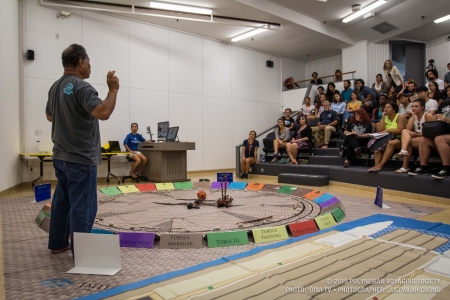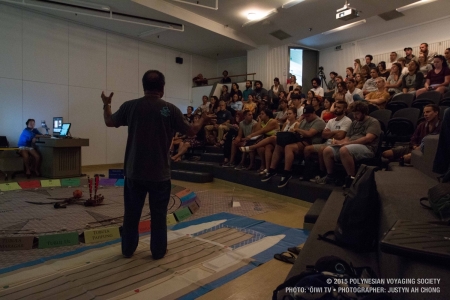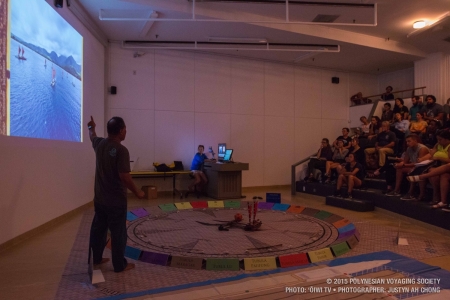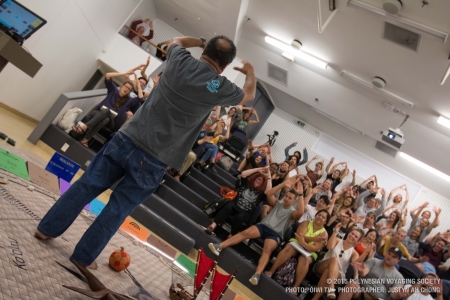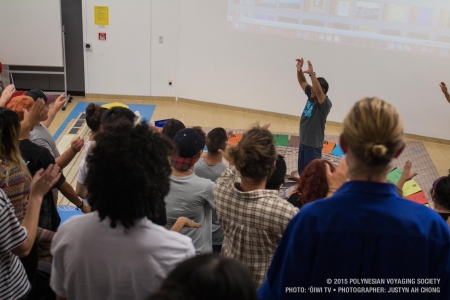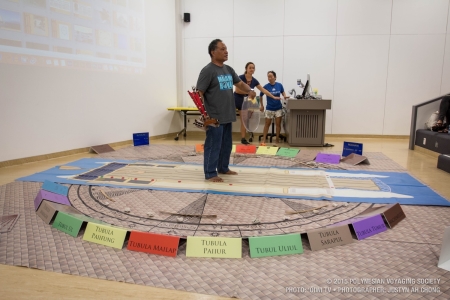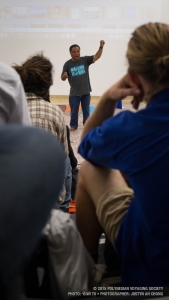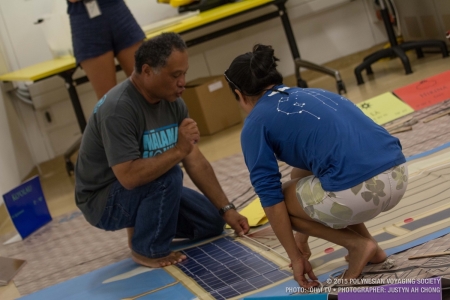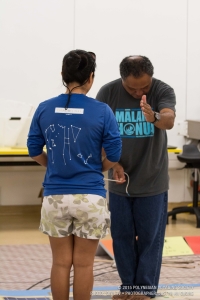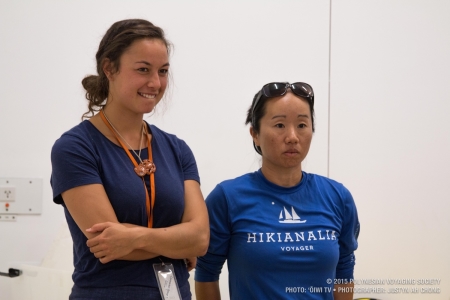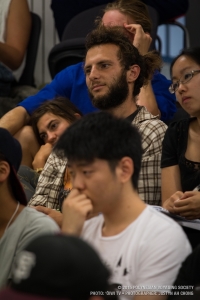
Crew Blog | Linda Furuto: He Lani Ko Luna, He Honua Ko Lalo
- Posted on 1 Apr 2015
- In Crew Blogs, Newsletter, Teachers
Pwo (Master) Navigator Kālepa Baybayan was invited to the University of Auckland to present the Hawaiian Star Compass and discuss the art of traditional navigation. I had the pleasure of attending and participating in the presentation as a crewmember on the Aotearoa Education Outreach Leg. The title of his lecture was He Lani Ko Luna, He Honua Ko Lalo translated as “The Heavens Above, The Earth Below.” According to Kālepa, “My job as navigator is for everyone to sail their waka to the correct horizon. The star compass is about the symbiotic relationship between all living things. The sky bears witness to actions on the land.” He taught participants that the world is our classroom, and reawakened me to the idea that there are answers found in the oceans, land, and skies that surround us.
 This is my third leg on Hōkūle‘a’s Worldwide Voyage with Pwo Navigator Kālepa Baybayan as my kumu, captain, navigator, and hero. My first leg was from Hawai‘i to Tahiti; my second was from Pago Pago to Apia to Olohega; and my current leg is in Aotearoa. I learn something new each time under Kālepa’s tutelage, especially about how the heavens and oceans have deeply significant cultural and scientific connections.
This is my third leg on Hōkūle‘a’s Worldwide Voyage with Pwo Navigator Kālepa Baybayan as my kumu, captain, navigator, and hero. My first leg was from Hawai‘i to Tahiti; my second was from Pago Pago to Apia to Olohega; and my current leg is in Aotearoa. I learn something new each time under Kālepa’s tutelage, especially about how the heavens and oceans have deeply significant cultural and scientific connections.
On my three voyages with Kālepa, he has patiently trained me as an apprentice navigator. In doing so, I have had many opportunities to analyze and study the star compass with him utilizing practical applications at sea. However, while sitting in the lecture hall at the University of Auckland, I was able to engage with the star compass and his teachings on an intrapersonal level that opened my perspective on what our kuleana is on this Auckland Education Outreach leg, and how Kālepa is a perfect leader to guide us on this small journey of our larger Worldwide Voyage.
 This Aotearoa Education Outreach leg is all about engaging with learners of all ages on what we are doing to mālama honua – care for our Earth, and how we are navigating our way – both metaphorically and physically on the voyage through our traditional celestial navigation. For myself, I’ve been able to share and demonstrate the star compass with students around the ages of 6-11. On this leg, Kālepa has been my alakaʻi, or leader, in conducting these demonstrations. The process is very simple and perfectly geared for learners of those ages. But in this college setting, it was interesting for me to see Kālepa transition his star compass teaching from 6-11 year olds to university students.
This Aotearoa Education Outreach leg is all about engaging with learners of all ages on what we are doing to mālama honua – care for our Earth, and how we are navigating our way – both metaphorically and physically on the voyage through our traditional celestial navigation. For myself, I’ve been able to share and demonstrate the star compass with students around the ages of 6-11. On this leg, Kālepa has been my alakaʻi, or leader, in conducting these demonstrations. The process is very simple and perfectly geared for learners of those ages. But in this college setting, it was interesting for me to see Kālepa transition his star compass teaching from 6-11 year olds to university students.
 Instantly, I found myself looking at the star compass not as an apprentice navigator, not as an outreach presenter, but as an academic. Kālepa had seamlessly shifted his presentation, and made it applicable and interesting for these scholars. I was impressed, and reminded about the skill required to be an inspiring and effective educator. Kālepa is a skilled teacher, educator, and mentor; he teaches apprentice navigation on the canoe, he shares the star compass with children in elementary school, and even adults in a university setting. At each of these presentations, I have witnessed a change occurring. Our mission is to perpetuate the art and science of traditional Pacific Island voyaging and the spirit of exploration through the world as our classroom. We transfer knowledge of natural elements such as the stars, winds, and ocean waves to our schools in the form of science, technology, engineering and mathematics. People are seeing that the star compass is not just a compass – it is a reminder that the world is our classroom. And at the same time, there is also an understanding that it takes both academics and an intimate relationship to place in order to really learn in this world.
Instantly, I found myself looking at the star compass not as an apprentice navigator, not as an outreach presenter, but as an academic. Kālepa had seamlessly shifted his presentation, and made it applicable and interesting for these scholars. I was impressed, and reminded about the skill required to be an inspiring and effective educator. Kālepa is a skilled teacher, educator, and mentor; he teaches apprentice navigation on the canoe, he shares the star compass with children in elementary school, and even adults in a university setting. At each of these presentations, I have witnessed a change occurring. Our mission is to perpetuate the art and science of traditional Pacific Island voyaging and the spirit of exploration through the world as our classroom. We transfer knowledge of natural elements such as the stars, winds, and ocean waves to our schools in the form of science, technology, engineering and mathematics. People are seeing that the star compass is not just a compass – it is a reminder that the world is our classroom. And at the same time, there is also an understanding that it takes both academics and an intimate relationship to place in order to really learn in this world.
 It is my understanding that the star compass is rooted in both mathematical practice and cultural wayfinding knowledge. For example, the Hawaiian star compass is comprised of 32 equidistant star houses each 11.25 degrees apart. There are markers and indicators on the canoes that reminds us of these navigational markers and mathematical ques. Then there are other markers or indicators that are constantly surrounding you when at sea – it is the heavens, the winds, the waves, and the living ecosystem swimming along the canoe or soring above the sails. The edge of the star compass is the horizon, where the sky touches the land or sea. Everything within those boundaries is a part of the compass – he lani ko luna, he honua ko lalo.
It is my understanding that the star compass is rooted in both mathematical practice and cultural wayfinding knowledge. For example, the Hawaiian star compass is comprised of 32 equidistant star houses each 11.25 degrees apart. There are markers and indicators on the canoes that reminds us of these navigational markers and mathematical ques. Then there are other markers or indicators that are constantly surrounding you when at sea – it is the heavens, the winds, the waves, and the living ecosystem swimming along the canoe or soring above the sails. The edge of the star compass is the horizon, where the sky touches the land or sea. Everything within those boundaries is a part of the compass – he lani ko luna, he honua ko lalo.
 On this day, the biggest lesson I take away from the star compass is that the navigator is always aware of his/her surroundings and is able to make decisions based on guidance from the heavens above to the earth below. Kālepa has shown me by example how to translate our traditional knowledge to various participants. He has been instrumental in translating this art of navigation into curriculum that can be understood and valued in a classroom environment and ultimately, passed on to a next generation.
On this day, the biggest lesson I take away from the star compass is that the navigator is always aware of his/her surroundings and is able to make decisions based on guidance from the heavens above to the earth below. Kālepa has shown me by example how to translate our traditional knowledge to various participants. He has been instrumental in translating this art of navigation into curriculum that can be understood and valued in a classroom environment and ultimately, passed on to a next generation.
My kuleana is to follow in the treasured path of our ancestors in order to navigate a better future. As I continue to voyage, I will strive to always remember hero’s like Kālepa in order to find my way.
Please help keep us sailing for future generations. All contributions make a difference for our voyage. Mahalo nui loa!

